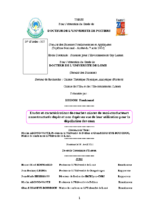Kodom Tomkouani
Études et caractérisations de couches minces de semi-conducteurs nanostructurés dopés et non dopés en vue de leur utilisation pour la dépollution des eaux
frConsulter le texte intégral de la thèse (format PDF)

Résumé
Français
Études et caractérisations de couches minces de semi-conducteurs nanostructurés dopés et non dopés en vue de leur utilisation pour la dépollution des eaux
Ce présent mémoire a porté sur l'étude et la caractérisation des couches minces de quelques photocatalyseurs non dopés et dopés à l'azote et ou avec le fluor ou le soufre. Les qualités photocatalytiques de l'oxyde de titane sont limitées par sa large bande interdite de 3,2 eV. Le dopage vise une plus grande sensibilisation du matériau obtenu. Il a été réalisé par la méthode hydrothermale en ce qui concerne le dioxyde de titane (P25) (TiO2 et TiO2-N). Le dioxyde de titane a été également synthétisé par la méthode sol gel. Le dopage à l'azote a été réalisé dans les deux cas en utilisant le chlorure d'ammonium comme précurseur d'azote. La synthèse par précipitation d'autres photocatalyseurs (TiOxNyFz) a été également réalisée. Les couches minces sont préparées par la technique d'électrophorèse ou par la technique " doctor blade ". L'analyse par DRX indique que la phase anatase est dominante. La spectroscopie UV-Visible et la spectroscopie d'action montrent une plus importante sensibilisation des matériaux dopés pouvant absorber jusqu'aux environs de 500 nm. L'analyse thermogravimétrique montre une stabilité induite due à la présence de l'azote dans les photocatalyseurs sol gel et la spectroscopie infrarouge indique l'existence de l'azote par la bande de vibration N-H ou N-O à 1431 cm-1. La voltampérométrie et la chronoampérométrie ont été utilisées pour mettre en évidence la photoactivité de ces matériaux. L'augmentation du taux de dopage entraine une diminution du photocourant. Le mécanisme par lequel le dopage induit une sensibilisation dans le domaine visible a été étudié via la spectroscopie d'impédance électrochimique et la variation du potentiel de circuit...
- Oxyde de titane
- Photoélectrochimie
- Colorants -- Chimie
- Oxydation
English
Studies and characterization of doped and non-doped of thin layer nanostructured semiconductors for water depollution
This work reports on the study and the characterization of thin layers of titanium dioxide un-doped and doped either with nitrogen and/or with fluorine or sulphur. Titanium dioxide possesses a large band gap 3.2 eV. The reduction of the optical threshold energy of TiO2 and the consequent possibility of using economical and ecological sunlight instead of UV irradiation in photocatalysis is expected to have tremendous applications. Doping was made by hydrothermal method with regard to titanium dioxide (P25) (TiO2 and TiO2-N). Titanium dioxide was also synthesized by sol gel method. Ammonium chloride was used as nitrogen precursor. The synthesis by precipitation was also used for other photocatalysts (TiOXNyFZ). Thin layers were prepared by electrophoresis or "doctor blade" techniques. X-ray diffraction (XRD) and Raman spectroscopy analyses demonstrated that both samples were anatase phase. The UV-Visible spectroscopy and action spectra showed that doped materials absorb visible light until 500 nm. Thermal analysis shows that doped nitrogen in TiO2 could prevent phase transition of anatase to rutile and then stabilize the anatase phase. FTIR analysis indicates that some nitrogen atoms in N-doped materials existed in the form of N-H or N-O. The photoelectrochemical studies via voltammetry and chronoamperometry, were used to show the photoactivity of these materials. The increase of doping precursor reduces the photocurrent. The mechanism by which doping induces a shift in the visible spectrum was studied via the electrochemical impedance spectroscopy and the change of the open circuit potential. The flat band potential as well as the density of donors is calculated...
Notice
- Diplôme :
- Doctorat d'Université
- Établissement de soutenance :
- Université de Poitiers
- Établissement de co-tutelle :
- Université de Lomé, Faculté des Sciences (FDS) (Togo)
- UFR, institut ou école :
- UFR des sciences fondamentales et appliquées (SFA)
- Laboratoire :
- Laboratoire de catalyse en chimie organique - LACCO (Poitiers)
- Domaine de recherche :
- Chimie théorique, physique, analytique
- Directeur(s) de thèse :
- Nicolas Alonso-Vante, Gbandi Djaneye-Boundjou
- Date de soutenance :
- 26 avril 2011
- Président du jury :
- Jean-Marie Herrmann
- Rapporteurs :
- Jean-Marie Herrmann, Jean Boukary Legma
- Membres du jury :
- Nicolas Alonso-Vante, Gbandi Djaneye-Boundjou, Honoré Kossi Koumaglo
Menu :
-
-
À propos d'UPthèses
-
Voir aussi
Annexe :
-
Une question ?
Avec le service Ubib.fr, posez votre question par chat à un bibliothécaire dans la fenêtre ci-dessous :
ou par messagerie électronique 7j/7 - 24h/24h, une réponse vous sera adressée sous 48h.
Accédez au formulaire...
Université de Poitiers - 15, rue de l'Hôtel Dieu - 86034 POITIERS Cedex - France - Tél : (33) (0)5 49 45 30 00 - Fax : (33) (0)5 49 45 30 50
these@support.univ-poitiers.fr -
Crédits et mentions légales
